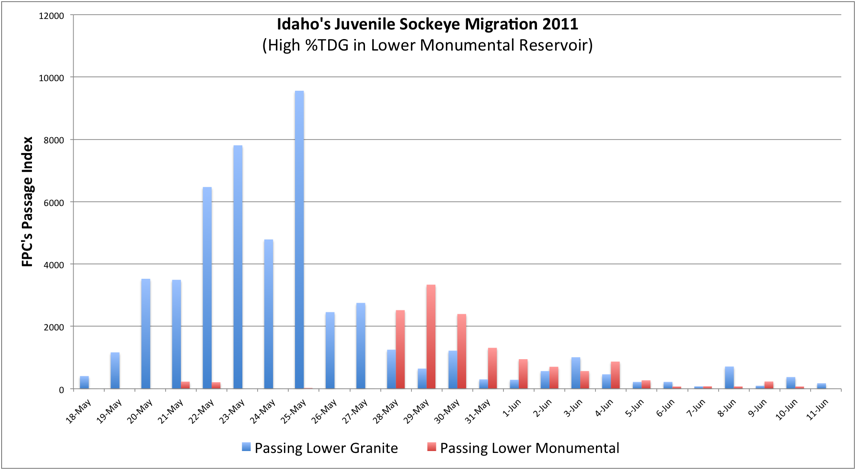forum
library
tutorial
contact

Levels of Gas Bubble Trauma on Migrating Salmon,
Steelhead Not Alarming at This Point
by StaffColumbia Basin Bulletin, June 3, 2011
|
the film forum library tutorial contact |

|
Levels of Gas Bubble Trauma on Migrating Salmon,
by Staff |
A massive and continued outpouring down through the Columbia-Snake River system over the past couple of weeks has pushed water over the banks in many places and complicated the tasks of dam operators trying both to minimize flow damage and hold down "total dissolved gas" levels that could ultimately harm migrating salmon and other aquatic life.
TDG is at extreme levels in the upper mid-Columbia where the Bureau is flushing large volumes of water in order to maintain space that will soon be refilled with mountain runoff.
Flows at Bonneville Dam on the lower Columbia topped 500,000 cubic feet per second on a daily average over the past week after a quick rise from only about 260 kcfs in early May. About 60 percent of that volume in recent days has been spilled. The Columbia River at Vancouver has been a foot or so above minimum flood stage since May 27, washing over lower lying areas.
Gas levels elsewhere are high, but not nearly as high as in the mid-Columbia. Under the federal Biological Opinion for Columbia Basin salmon and steelhead listed under the Endangered Species Act, hydro managers aim to keep TDG levels below 120 percent in the mainstem dams' tailraces.
McNary Dam, which is just downstream from the Columbia-Snake confluence, had an average tailrace reading of 127 percent TDG Thursday. The first dam downstream of Hells Canyon, Lower Granite in southeast had a 121.2 percent tailrace average and the next dam downstream, Little Goose, had a 124.9 percent reading.


Troubles erupted last week at Little Goose when a transformer problem forced the Corps to shut down the powerhouse almost entirely for seven days. That meant almost all of the river had to be spilled during that period and spill is a primary culprit in stirring up gas.
The Fish Passage Center's Margaret Filardo theorized that resulted in increased TDG, and an increased incidence of "gas bubble trauma" being charted by monitors at the next dam downstream.
"That's when we started seeing trouble," Filardo said. The signs of GBT at Lower Monumental jumped to 4.8 percent of the fish sampled on May 25 just before the outage to 23 percent on May 28, then dropped down to 4 percent June 1, the day Little Goose went back on. Few of the cases ranked above a 1 on a scale of 4 with a 4 being a fish with the most severe GBT signs. No 4s were charted.
The signs and levels of GBT seen so far on the lower Snake and Columbia are not alarming, at least so far, Filardo said.
"Right now it's all good," Filardo said of strong, cool, fast river flows and plenty of spill to help get juvenile fish downriver and through the hydro system quickly.
Flows throughout the mainstem river are in excess of the powerhouse capacities. As a result dam are being forced to also spill water in excess of the court ordered spill for fish passage.
"Generally the hydro system is running full out" with all turbines whirling unless they are out of service for maintenance or some other reason, said Michael Milstein of the Bonneville Power Administration. "They're basically maxed out as long as there is a place to send the power."
The federal power marketing agency has on numerous occasions over the past two weeks implemented a new policy in which it partially and temporarily limits the production of non-hydro energy, including fossil-fuel and other thermal generation and wind energy that was entering its transmission system. That "redispatching" of power during times of low demand keeps more of the turbines turning and reduces the volume spilled.
TDG has taken a toll. A Pacific Seafood net pen operation above Chief Joseph Dam on the mid-Columbia has suffered hundreds of thousands in mortalities, which the company blames on high levels of TDG stirred up by high volume releases from Grand Coulee Dam upstream. The company is raising trout in the net pens.
The FPC summarized its Smolt Monitoring Program gas bubble trauma monitoring data collected to-date during the 2011 juvenile spring migration at the request of the Washington Department of Fish and Wildlife's Bill Tweit.
The resulting May 27 memo noted that migrating salmon and steelhead are much less likely to be affected by GBT than the fish than fish that are confined to areas with high levels of TDG.
Among its conclusions were that:
Related Pages:
Water Supply Still Grows as Runoff Begins to Fill Reservoirs by Bill Rudolph,
NW Fishletter, 6/3/11
High River Flows Prompt BPA Action by Staff, BPA Journal, 6/11
Judge says Corps Complied with CWA over Snake Dam Operations by Bill Rudolph, NW Fishletter, 1/17/3
learn more on topics covered in the film
see the video
read the script
learn the songs
discussion forum
